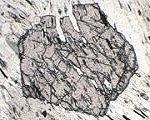Practical Aspects of Mineral Thermobarometry
Biotite activity coding
KFMASH
Two formulations of the ordered biotite model seem possible, differing in their definition of the order parameter. The first coding below is introduced as a worked example in the program documentation for data file construction, and can be found in thdkfm.txt, supplied with the thermodynamic data set in the file TC31win.zip.
% Ordered biotite from program documentation
bi 4
x(bi) 0.4 % bulk Fe/(Fe + Mg)
y(bi) 0.25 % x(Al,M1)
N(bi) 0.14 % 3(x - x(Fe,M2))
p(phl) 2 2 1 1 -1 x 1 1 -1 y
1 0 1 -2/3 N
p(ann) 1 1 0 2 1 x -1/3 N
p(east) 1 1 0 1 1 y
p(obi) 2 2 0 1 -1 x 0 1 1 y
1 0 1 1 N
sf
W(phl,ann) 9 0 0
W(phl,east) 10 0 0
W(phl,obi) 3 0 0
W(ann,east) -1 0 0
W(ann,obi) 6 0 0
W(east,obi) 10 0 0
7 % no of site fractions
x(Al,M1) 1 1 0 1 1 y
x(Fe,M1) 2 2 0 1 1 x 1 1 -1 y
1 0 1 2/3 N
x(Mg,M1) 2 2 1 1 -1 x 1 1 -1 y
1 0 1 -2/3 N
x(Fe,M2) 1 1 0 2 1 x -1/3 N
x(Mg,M2) 1 1 1 2 -1 x 1/3 N
x(Al,T1) 1 1 1/2 1 1/2 y
x(Si,T1) 1 1 1/2 1 -1/2 y
phl 4 4 x(Mg,M1) 1 x(Mg,M2) 2 x(Al,T1) 1 x(Si,T1) 1
check 0 0 0
ann 4 4 x(Fe,M1) 1 x(Fe,M2) 2 x(Al,T1) 1 x(Si,T1) 1
check 1 0 0
east 1 3 x(Al,M1) 1 x(Mg,M2) 2 x(Al,T1) 2
check 0 1 0
obi 4 4 x(Fe,M1) 1 x(Mg,M2) 2 x(Al,T1) 1 x(Si,T1) 1
make 2 phl 2/3 ann 1/3
DQF -10.73 0 0
check 1/3 0 1
An alternative coding can be adapted from the account of the ordered biotite model in Tim Holland's document biotiteAX.pdf. Here, the parameter N represents the fraction of Fe in M1 in excess of the bulk Fe/(Fe+Mg) distribution.
% Ordered biotite from Tim Holland's document biotiteAX.pdf
bi 4
x(bi) 0.4 % bulk Fe/(Fe + Mg)
y(bi) 0.25 % x(Al,M1)
N(bi) 0.14 % extra Fe in M1
p(phl) 2 2 1 1 -1 x 1 1 -1 y
1 0 1 -1 N
p(ann) 1 1 0 2 1 x -1/2 N
p(east) 1 1 0 1 1 y
p(obi) 2 2 0 1 -1 x 0 1 1 y
1 0 1 3/2 N
sf
W(phl,ann) 9 0 0
W(phl,east) 10 0 0
W(phl,obi) 3 0 0
W(ann,east) -1 0 0
W(ann,obi) 6 0 0
W(east,obi) 10 0 0
7 % no of site fractions
x(Al,M1) 1 1 0 1 1 y
x(Fe,M1) 2 2 0 1 1 x 1 1 -1 y
1 0 1 1 N
x(Mg,M1) 2 2 1 1 -1 x 1 1 -1 y
1 0 1 -1 N
x(Fe,M2) 1 1 0 2 1 x -1/2 N
x(Mg,M2) 1 1 1 2 -1 x 1/2 N
x(Al,T1) 1 1 1/2 1 1/2 y
x(Si,T1) 1 1 1/2 1 -1/2 y
phl 4 4 x(Mg,M1) 1 x(Mg,M2) 2 x(Al,T1) 1 x(Si,T1) 1
check 0 0 0
ann 4 4 x(Fe,M1) 1 x(Fe,M2) 2 x(Al,T1) 1 x(Si,T1) 1
check 1 0 0
east 1 3 x(Al,M1) 1 x(Mg,M2) 2 x(Al,T1) 2
check 0 1 0
obi 4 4 x(Fe,M1) 1 x(Mg,M2) 2 x(Al,T1) 1 x(Si,T1) 1
make 2 phl 2/3 ann 1/3
DQF -10.73 0 0
check 1/3 0 2/3
Mn-bearing biotite
The simplest treatment of Mn in biotite is to assume that the minor amount is distributed equally in the one M1 and two M2 sites, displacing Mg and Fe. Now the simple definition of N(bi) used in the first formulation does not hold, and the second formulation will be more convenient:
% Ordered Mn-bearing biotite
bi 4
x(bi) 0.4 % bulk Fe/(Fe + Mg)
y(bi) 0.25 % x(Al,M1)
N(bi) 0.14 % extra Fe in M1
m(bi) 0.02 % x(Mn,M12)
p(phl) 2 2 1 1 -1 x 1 2 -1 y -1 m
1 0 1 -1 N
p(ann) 2 2 0 1 1 x 1 1 -1 m
1 0 1 -1/2 N
p(east) 1 1 0 1 1 y
p(obi) 2 2 0 1 -1 x 0 1 1 y
1 0 1 3/2 N
p(mnbi) 1 1 0 1 1 m
sf
W(phl,ann) 9 0 0
W(phl,east) 10 0 0
W(phl,obi) 3 0 0
W(phl,mnbi) 0 0 0
W(ann,east) -1 0 0
W(ann,obi) 6 0 0
W(ann,mnbi) 0 0 0
W(east,obi) 10 0 0
W(east,mnbi) 0 0 0
W(obi,mnbi) 0 0 0
8 % no of site fractions
x(Al,M1) 1 1 0 1 1 y
x(Fe,M1) 2 2 0 1 1 x 1 2 -1 y -1 m
1 0 1 1 N
x(Mg,M1) 2 2 1 1 -1 x 1 2 -1 y -1 m
1 0 1 -1 N
x(Fe,M2) 2 2 0 1 1 x 1 1 -1 m
1 0 1 -1/2 N
x(Mg,M2) 2 2 1 1 -1 x 1 1 -1 m
1 0 1 1/2 N
x(Mn,M12) 1 1 0 1 1 m
x(Al,T1) 1 1 1/2 1 1/2 y
x(Si,T1) 1 1 1/2 1 -1/2 y
phl 4 4 x(Mg,M1) 1 x(Mg,M2) 2 x(Al,T1) 1 x(Si,T1) 1
check 0 0 0 0
ann 4 4 x(Fe,M1) 1 x(Fe,M2) 2 x(Al,T1) 1 x(Si,T1) 1
check 1 0 0 0
east 1 3 x(Al,M1) 1 x(Mg,M2) 2 x(Al,T1) 2
check 0 1 0 0
obi 4 4 x(Fe,M1) 1 x(Mg,M2) 2 x(Al,T1) 1 x(Si,T1) 1
make 2 phl 2/3 ann 1/3
DQF -10.73 0 0
check 1/3 0 2/3 0
mnbi 4 3 x(Mn,M12) 3 x(Al,T1) 1 x(Si,T1) 1
check 0 0 0 1
So far, this seems to work. N has a maximum value of 2/3 (in pure obi), rather than 1 in the other formulation.
Content last modified 28 Aug 03
